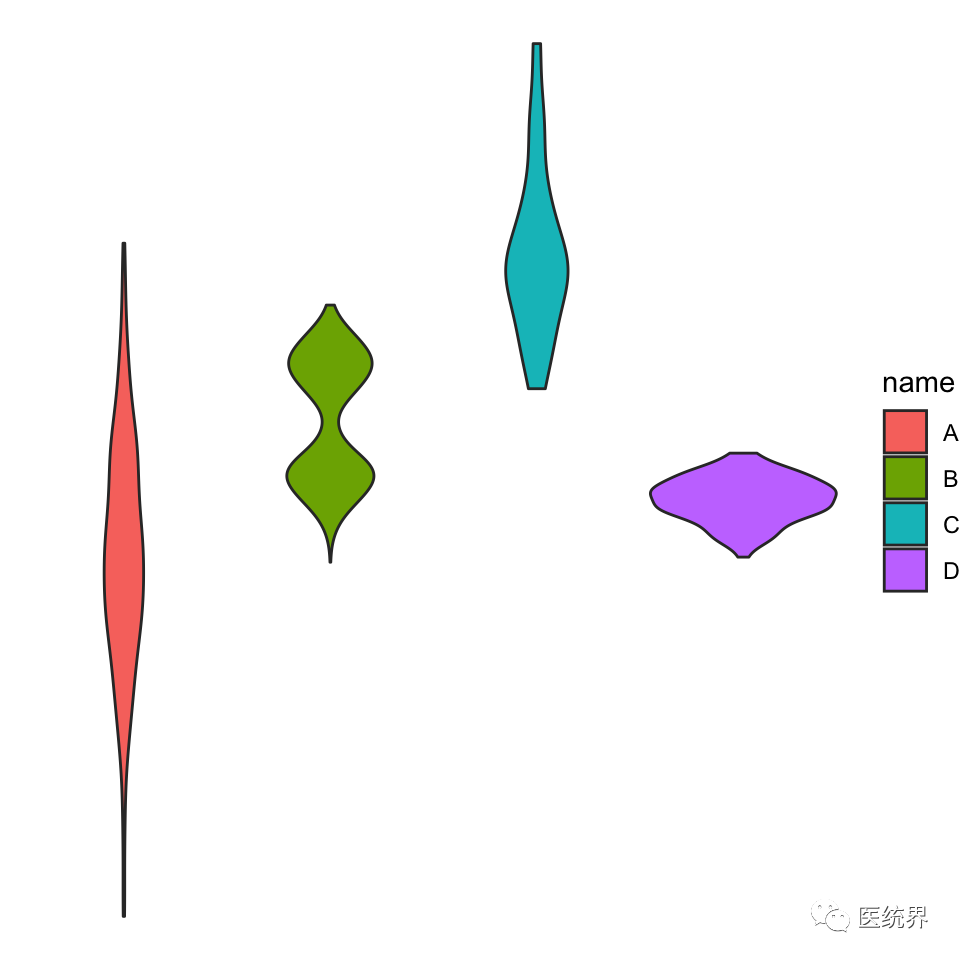小提琴图是箱线图与核密度图的结合,因其形态类似小提琴而得名,可全面展示数据的分位数和密度,在进行多类别数据分布对比的时候,是非常适宜的可视化手段。R语言的小提琴图具有语法简单,图片美观等特点。具体如下:
基本用法 长数据格式作图小提琴图最基本的作图就是ggplot2的geom_violin()函数了
其基本用法为:
#加载ggplot2包
library(ggplot2)
# 创建数据
data <- data.frame(
name=c( rep("A",500), rep("B",500), rep("B",500), rep("C",20), rep('D', 100) ),
value=c( rnorm(500, 10, 5), rnorm(500, 13, 1), rnorm(500, 18, 1), rnorm(20, 25, 4), rnorm(100, 12, 1) )
)
# 小提琴图的基本绘制
p <- ggplot(data, aes(x=name, y=value, fill=name)) + geom_violin()
p
结果图片为:

宽数据格式作图data_wide <- iris[ , 1:4]
library(tidyr)
library(ggplot2)
library(dplyr)
data_wide %>%
gather(key="MesureType", value="Val") %>%
ggplot( aes(x=MesureType, y=Val, fill=MesureType)) +
geom_violin()
结果图片为:

进一步美化 加上样本量,绘制箱图# Libraries
library(ggplot2)
library(dplyr)
library(hrbrthemes)
library(viridis)
# create a dataset
data <- data.frame(
name=c( rep("A",500), rep("B",500), rep("B",500), rep("C",20), rep('D', 100) ),
value=c( rnorm(500, 10, 5), rnorm(500, 13, 1), rnorm(500, 18, 1), rnorm(20, 25, 4), rnorm(100, 12, 1) )
)
# sample size
sample_size = data %>% group_by(name) %>% summarize(num=n())
# Plot
data %>%
left_join(sample_size) %>%
mutate(myaxis = paste0(name, "\n", "n=", num)) %>%
ggplot( aes(x=myaxis, y=value, fill=name)) +
geom_violin(width=1.4) +
geom_boxplot(width=0.1, color="grey", alpha=0.2) +
scale_fill_viridis(discrete = TRUE) +
theme_ipsum() +
theme(
legend.position="none",
plot.title = element_text(size=11)
) +
ggtitle("A Violin wrapping a boxplot") +
xlab("")
结果图为:

两x轴y轴互相调换,绘制横向图# Libraries
library(ggplot2)
library(dplyr)
library(tidyr)
library(forcats)
library(hrbrthemes)
library(viridis)
# Load dataset from github
data <- read.table("https://raw.githubusercontent.com/zonination/perceptions/master/probly.csv", header=TRUE, sep=",")
# Data is at wide format, we need to make it 'tidy' or 'long'
data <- data %>%
gather(key="text", value="value") %>%
mutate(text = gsub("\\.", " ",text)) %>%
mutate(value = round(as.numeric(value),0)) %>%
filter(text %in% c("Almost Certainly","Very Good Chance","We Believe","Likely","About Even", "Little Chance", "Chances Are Slight", "Almost No Chance"))
# Plot
p <- data %>%
mutate(text = fct_reorder(text, value)) %>% # Reorder data
ggplot( aes(x=text, y=value, fill=text, color=text)) +
geom_violin(width=2.1, size=0.2) +
scale_fill_viridis(discrete=TRUE) +
scale_color_viridis(discrete=TRUE) +
theme_ipsum() +
theme(
legend.position="none"
) +
coord_flip() + # This switch X and Y axis and allows to get the horizontal version
xlab("") +
ylab("Assigned Probability (%)")
p
结果图为:


往期回顾:
stata做meta分析系列
stata简介
二分类和连续性资料做meta分析
发表偏倚检测
R做发表偏倚检测
网状meta系列
网状meta分析的解读
R做网状meta分析
其他
热图的绘制
聚类分析的可视化

医统界更多医统内容
长按关注公众号